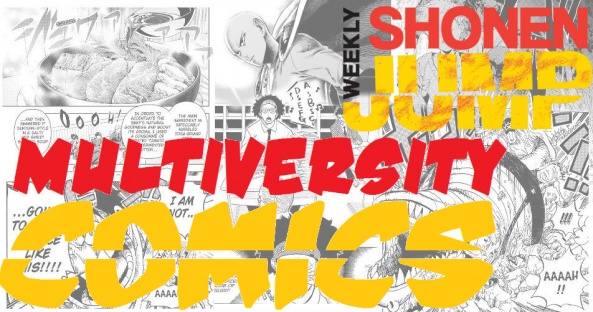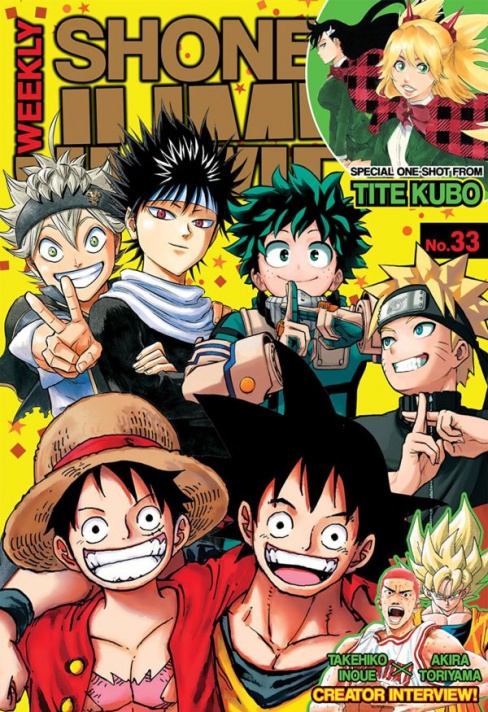
Welcome to This Week in Shonen Jump, in which a rotating duo of Multiversity staffers take a look at two stories contained in each installment of Viz Media’s Weekly Shonen Jump. For the uninitiated, Weekly Shonen Jump is an anthology that delivers more than 200 pages of manga of all varieties. We hope that you’ll join us in exploring the world of Weekly Shonen Jump each week. If you are unfamiliar, you can read sample chapters and subscribe at Viz.com.

This week, Matt and Rowan check in with “Alice and Taiyo” and “Burn the Witch.” If you have any thoughts on these titles, or “One Piece,” “Dr. Stone,” “We Never Learn,” “The Promised Neverland,” “Black Clover,” “Food Wars,” or “My Hero Academia,” let us know in the comments!

Burn The Witch One-Shot
Written and Illustrated by Tite Kubo
Reviewed by Rowan Grover
POTENTIAL BLEACH-RELATED SPOILERS AHEAD!
Tite Kubo returns to mingling the fantastical with the everyday in his one-shot, “Burn The Witch”. Right off the bat, I’m impressed with how Kubo is able to develop multiple characters so well in a short amount of time. From the start, Noel appears to be the only one with depth, fighting off leering guys and filled with self-confidence. After this we get the Bargo, a brash high-schooler with an uncomfortable obsession with seeing Noel’s panties, followed by Noel’s co-witch Nini Spangle, someone seemingly obsessed with self-appearance and vanity. They seem like typical support cast characters that would wear a little thin, but Kubo develops them in unexpected and compelling ways. By the end of the tale, we see more that Bargo cares more about his friend that was lost to a Dragon, and tries to appeal to his good nature rather than continue to be an annoying pervert. We then also see that Nini works as the voice of reason between her and Noel, trying to convince Bargo to run from the obviously terrifying sight of a Dragon and filling in Noel on data about different types of Dragons. It’s a great way to hook readers who might be more cynical by playing with expectations.
What’s great is how Kubo builds up a world that feels distinctly unique and fleshed out on it’s own, yet still subtly connects to Kubo’s “Bleach” in a way that feels organic and unforced. Like the aforementioned manga, unique creatures exist in this universe, although named Dragons as opposed to Hollows. It gives the book a more expansive feel that these aren’t just foes or creatures to be hunted, but Kubo builds them up as being part of Reverse London’s history, agriculture, and general lifestyle. Having Noel and Nini go on their first mission to farm champagne grapes from a Dragon as opposed to just hunting it is fantastic, and gives the world a very real feel. For previous fans of “Bleach” who find out about this world existing in the same continuity, there’s a myriad of easter eggs to be found on the second read. When Nini brings up about how much simpler it is that with Dragons in Japan, “They kill them all, no questions asked”. It not only references the existence of Shinigami in this continuity, but that Dragons may be a form of Hollow, but simply how they are referred to and have grown in Europe. Again, it gives a real feeling of interconnectivity and makes the narrative world feel genuine and lived-in.
Kubo is renowned as a veritable titan in the field of character design, and that’s no less true in “Burn The Witch”. The very first page, combined with the dialogue “I’m fond of uniforms” gives you a sense of what to expect across the board here, which is a combination of sleek school style mixed with charming modern fashion. Noel herself is a little problematic, however. She’s the one that feels the most dated and probably most in-style to Kubo’s main era of drawing, with a short skirt and large bust. However, it’s only accentuated on the cover and on pinups, and Kubo never uses deliberate camera angles or panelling to accentuate, showing a lot of artistic development from his early “Bleach” days. She’s the only one who partially suffers from this, however – Nini has a much more modern costume, sporting a neat button up shirt with braces over the top, a stylish yet functional uniform considering her field of work. Kubo accentuates what he’s best at – character design that blends modern fashion with a fantasy aesthetic, and has thankfully moved away from the dated sexualised designs of times past.
Continued belowWhat I do want to talk about is the amazing designs of the various Dragons appearing in this story. These aren’t your run-of-the-mill, classical European style. We get a sense of that when the narrative introduces us to the idea of Dragons contributing to all types of Reverse London society. Kubo has a fantastic design for each one of these functional creatures, whether it’s the tired looking, stalactite-sporting “Hammer Back”, or the elegant and smoother “Wooly Wally”. We do get a classical look when Osushi turns into a dragon, but it’s still dark and unique looking and suits the setting. The fantastic standout of the issue, however, is when Shelby transforms into a dragon. We get some insanely intuitive design work here, with Shelby’s head folding out like a conical strip of paper, with the inside lined with teeth to fold around prey like a terrifying Boa Constrictor. Combined with the blank, all-encompassing staring eyes, this creature serves a reminder as to why Kubo is one of the best in the biz when it comes to original and creative character designs.
“Burn The Witch” is a fantastic done-in-one story that serves as a great whole story for new fans, with a lot of fun easter eggs for long time Kubo fans. There’s some great narrative subversion with character stereotypes, and rich worldbuilding present. Top that off with stylish character designs and crazy original creatures, and you’ll be able to see why Tite Kubo is such a renowned creator in the Manga world.
Final Score: 9.0 – A fantastic self-contained story with plenty of easter eggs for “Bleach” fans, “Burn The Witch” is a masterclass in character development, world building and design.

Alice & Taiyo Chapter 3
Written and Illustrated by Takahide Totsuno
Reviewed by Matt Lune
This third chapter of “Alice & Taiyo” has been a fun, light-hearted adventure that concludes this latest Jump Start. There aren’t any real surprises here, but that’s almost not the point of stories like this. There’s a formula that’s followed, and there’s something comforting about that familiar feeling you get at the beginning of a Shonen manga. In that sense, the music-oriented “Alice & Taiyo” feels like that summer playlist filled with songs you know all the words too and can’t help singing along.
Takahide Totsuno’s tale of a shy musical genius – Taiyo – being brought literally into the spotlight by an extrovert singer – Alice – has to be careful not to veer too far into simple male fantasy. There’s an element of simple male fantasy that’s intrinsic to the genre, of course, but the first chapter of “Alice & Taiyo” had a few voyeuristic moments that tipped the scales more towards male fanboy gratuity than actual wholesome adventure. Thankfully, those elements have been pretty absent in these last two installments, allowing the warmth of the story to shine through.
One of the core elements of the series is Taiyo’s awkwardness and his ability – via the outgoing Alice – to find himself in situations that push him far outside his comfort zone. To accentuate this, chapter 2 introduced Furuya, a rival to Taiyo and his opposite in almost every way. In a moment of further fanboy gratification, the beautiful and talented Alice concocts a simple plan to ditch the handsome jock in favor of the shy nerd Taiyo. It’s a little cheesy (okay, a lot cheesy), but there are a warmth and even innocence displayed in this chapter that elevates it beyond the cliched tropes.
That warmth comes from the genuine humor – an early joke about Alice’s schemes to get them on the stage is really funny- and the love of both music and performing that shines through. Totsuno’s art focuses on light and shade to effectively convey the brightness of the stage and the focus on the performers, and a few double-page spreads at key moments add to the feeling of importance and relevance of these two creatives joining forces, and it all comes together to form a sum greater than its parts.
While this particular jump start is over, it’s not hard to predict where this story will be going from here, but again that’s missing the point of a series like this. “Alice & Taiyo” may be cheesy, may be predictable, and may rely a little too often on tropes around male fantasy wish-fulfillment, but the humor, warmth, and heart shine through, and it’s worth catching the performance before the curtain drops.
Final Verdict: 7.9 – A light-hearted end to this jump-start, and the start of a bigger story.






